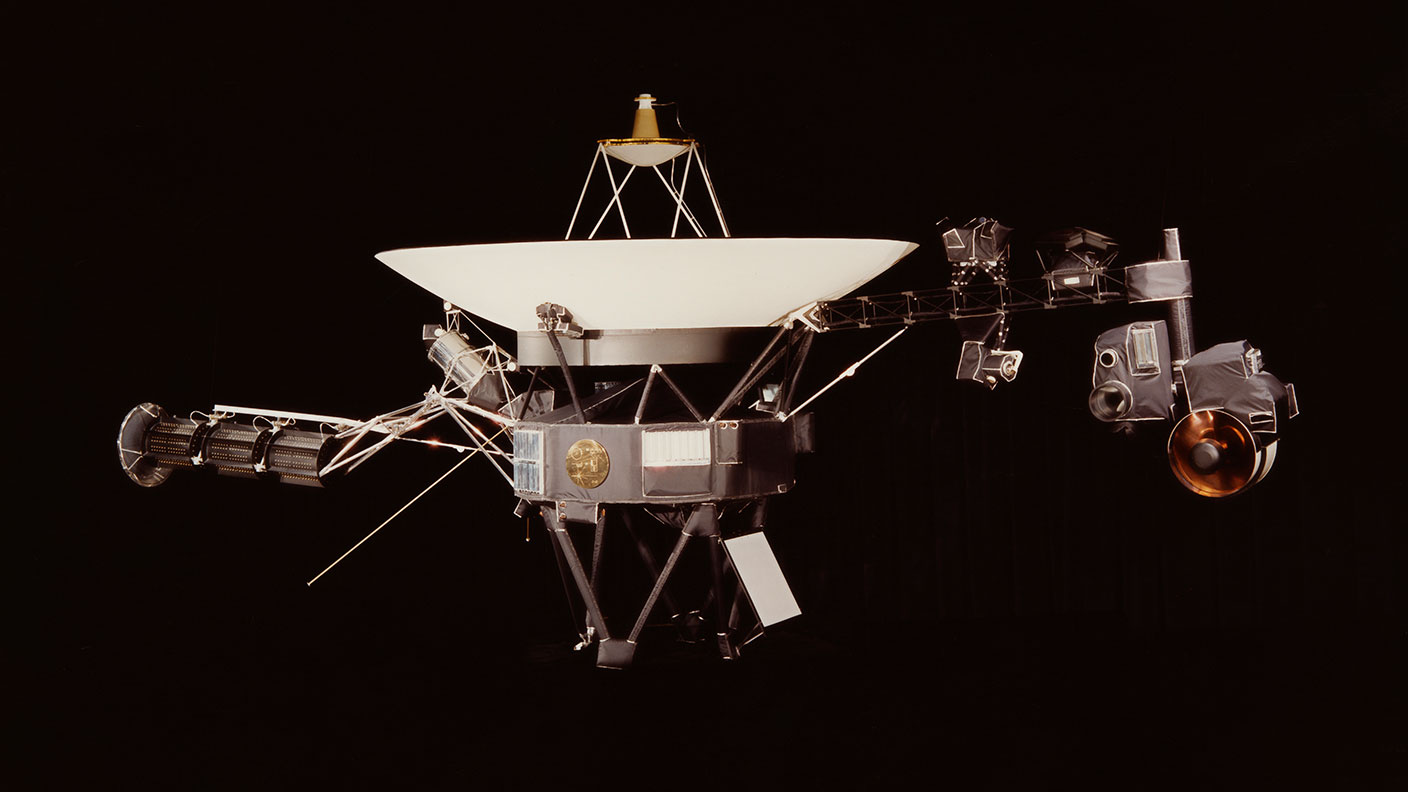25 August 2012: Voyager 1 enters interstellar space
On this day in 2012, the Voyager 1 spacecraft crossed into interstellar space, becoming the first manmade object to explore the space between the stars.


What do a recording of Chuck Berry's Johnnie B Goode, a photograph of a woman licking an ice cream and the sound of a chimpanzee have in common? They are all heading away from Earth at over 56,000 km per hour. These sounds and images are part of an eclectic mix recorded onto a gold-plated 12-inch copper disc, currently hitching a ride through the galaxy on the Voyager 1 spacecraft.
Originally named after the Mariner missions, Voyager 1 and its twin, Voyager 2, blasted off from Florida's Kennedy Space Flight Center in August and September 1977 on a mission to study Jupiter and Saturn. But the probes, on separate trajectories, far exceeded their goals.
From May 1972 to the point Voyager 2 encountered Neptune in 1989, the bill for the Voyager programme was $865m. That is, as Nasa points out, "a fraction of the daily interest on the US national debt". And when you consider that the probes are still returning data almost 40 years after their launch, you have to agree, that's not bad value for money. By comparison, the Mars Curiosity rover had a budget of $2.5 billion, while Europe's Rosetta comet mission, which included the Philae lander, cost €1.4 billion – not cheap.
MoneyWeek
Subscribe to MoneyWeek today and get your first six magazine issues absolutely FREE

Sign up to Money Morning
Don't miss the latest investment and personal finances news, market analysis, plus money-saving tips with our free twice-daily newsletter
Don't miss the latest investment and personal finances news, market analysis, plus money-saving tips with our free twice-daily newsletter
Having said goodbye to Neptune, the pair of spacecraft were given a new objective: to study the outer region of our solar system, known as the heliopause. Then, on 25 August 2012, Voyager 1 crossed into interstellar space. (To be completely accurate, it's not really possible to pinpoint this event to any specific day, but that's the date Nasa's sticking with.)
On that fateful day, Voyager 1 became the first, and so far only, manmade object to enter the space between the stars, bearing Earth's calling card. "The spacecraft will be encountered and the record played only if there are advanced spacefaring civilisations in interstellar space", said the late Dr Carl Sagan, the man behind the mix-tape.
So, here's hoping that an alien race so advanced as to stumble on this memento of Mankind will have hung on to their old turntables. If they find themselves fans of Chuck Berry, there's a good chance they will have. If they haven't, they can always extract the gold for portfolio insurance.
I'll leave you with this thought: in the time it's taken you to read this, Voyager 1 has travelled over 3,000 kilometres. But it will be another 40,000 years before it gets anywhere near another star system.
Get the latest financial news, insights and expert analysis from our award-winning MoneyWeek team, to help you understand what really matters when it comes to your finances.

-
 31 August 1957: the Federation of Malaya declares independence from the UK
31 August 1957: the Federation of Malaya declares independence from the UKFeatures On this day in 1957, after ten years of preparation, the Federation of Malaya became an independent nation.
-
 13 April 1960: the first satellite navigation system is launched
13 April 1960: the first satellite navigation system is launchedFeatures On this day in 1960, Nasa sent the Transit 1B satellite into orbit to provide positioning for the US Navy’s fleet of Polaris ballistic missile submarines.
-
 9 April 1838: National Gallery opens in Trafalgar Square
9 April 1838: National Gallery opens in Trafalgar SquareFeatures On this day in 1838, William Wilkins’ new National Gallery building in Trafalgar Square opened to the public.
-
3 March 1962: British Antarctic Territory is created
Features On this day in 1962, Britain formed the British Antarctic Territory administered from the Falkland Islands.
-
10 March 2000: the dotcom bubble peaks
Features Tech mania fanned by the dawning of the internet age inflated the dotcom bubble to maximum extent, on this day in 2000.
-
9 March 1776: Adam Smith publishes 'The Wealth of Nations'
Features On this day in 1776, Adam Smith, the “father of modern economics”, published his hugely influential book The Wealth of Nations.
-
 8 March 1817: the New York Stock Exchange is formed
8 March 1817: the New York Stock Exchange is formedFeatures On this day in 1817, a group of brokers moved out of a New York coffee house to form what would become the biggest stock exchange in the world.
-
7 March 1969: Queen Elizabeth II officially opens the Victoria Line
Features On this day in 1969, Queen Elizabeth II took only her second trip on the tube to officially open the underground’s newest line – the Victoria Line.

